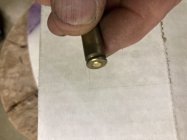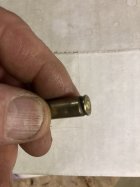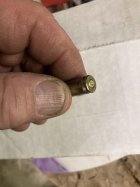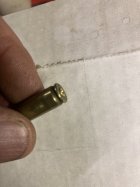I am sure once it is fired, the firing pin pushed the primer to the bottom of the pocket and once it fired, the pressure pushes the primer back to the bolt face thus making it like you seated it flush. Matt |
You are using an out of date browser. It may not display this or other websites correctly.
You should upgrade or use an alternative browser.
You should upgrade or use an alternative browser.
DUD Remington 7.5 small rifle bench rest primers
- Thread starter Nic Swink
- Start date
What pressure? There was no powder or bullet in the case. I guess I did not make that clear. With the 204 I even deadened the 7.5 down to where it was only 10% of normal.
I am sure once it is fired, the firing pin pushed the primer to the bottom of the pocket and once it fired, the pressure pushes the primer back to the bolt face thus making it like you seated it flush. Matt
It is not possible that any significant amount of pressure went back through the flash-hole and moved the 7.5 primer. And I really doubt there was any significant back-pressure in the .30-06 case. Not with an open case and an open bore.
I suppose I could deaden some 100% and try it, but IMO there is no need. The FP ain't moving the primer, not a normal one, anyway. With one of those that fall out after you press them in, sure, but not with one where the pocket is the least bit snug.
Last edited:
The pressure inside the primer cup. It doesn’t flow BACK through the flash hole. It builds in the pocket before it can all be expelled THROUGH the flash hole, in this scenario with not bullet or powder.
Although I’m not totally convinced there’s enough of it to move a primer in all but the loosest pockets. As I know mine didn’t even dislodge a bullet.
Although I’m not totally convinced there’s enough of it to move a primer in all but the loosest pockets. As I know mine didn’t even dislodge a bullet.
I will soak one overnight and try it. If a completely inert, proud primer is not moved forward by the FP, we will know.
^^^^ this right here. Those are way way way too deepIt may be the angle, but your primers look really deep ...
This is not an absolute. I run a little more neck tension on my ar 15 loads to prevent bullet push back. I missed one row of cartridges when I loaded a tray with powder. When fired, the primers went off and every one had a bullet in the case when ejected. and the report of the primer was not even as loud as the drop of the firing pin. And yes I did pull down the cartridges and the insides were sooted from the primersEveryone, please understand that the primer ALONE, with no powder whatsoever in the case, will push the bullet into the barrel at least an inch, usually more. Don't believe me? Try it!
your post right after that series of pictures is ironic!Oh, I absolutely agree, KY Windage. I don’t think that a shallow primer is to blame here. I actually meant to suggest that the primers aren’t “excessively deep” necessarily based on the photo.
I also reject the idea that a firing pin will fully seat a primer.
Absolutely correct.Actually I believe that they do the opposite. Matt
Rich Lee
rich lee
that is a posibilaty I have been reloading for 30 + years and I still get one once in a while that miss getting powder but those primers are to deep.Pull the bullets and see if you maybe forgot to put powder in them
Long ago a friend was having trouble with a 742 Rem rifle, the casings would stick in chamber after being fired. He got the bright idea of slicking casing with WD-40 in a ziplock bag. He had some that delayed when firing and some would not even fire. I may be wrong about the WD-40 but it was some kind of oil.
Long ago a friend was having trouble with a 742 Rem rifle, the casings would stick in chamber after being fired. He got the bright idea of slicking casing with WD-40 in a ziplock bag. He had some that delayed when firing and some would not even fire. I may be wrong about the WD-40 but it was some kind of oil.
Experimenting with WD-40-soaked primers (so that they don't go off, so that there is no question concerning "pressure" created by the primer), what I have found is that primers purposefully left exceedingly proud will get moved forward by the firing pin (though not past flush with the case, in any of the tested rifles), and the indentation will be reduced from normal. This is to be expected somewhat because when we seat primers by hand they usually go in easily for a ways and then it takes more and more pressure to push them in farther.Oh, I absolutely agree, KY Windage. I don’t think that a shallow primer is to blame here. I actually meant to suggest that the primers aren’t “excessively deep” necessarily based on the photo.
I also reject the idea that a firing pin will fully seat a primer.
However, deadened primers left only slightly proud are not moved forward at all by the FP (or are moved only to flush with the case) and the indentations are normal, in my rifles.
I have purposefully loaded many rounds slightly proud with live primers and gotten 5-shot groups that just as good or better than rounds with fully seated primers.
I'm sure you would get variations depending on how tight your pockets are, how hard your primers are and how what the condition of your FP/spring is.
I think the safe thing to do, accuracy-wise, is to seat fully, assuming your FP and spring are long/strong enough to reach that far and make a proper indentation. That way those primers that go in "too easily," because of a worn pocket, will be likely to ignite properly.
Or, if you want to seat flush, you might want to cull the cases you feel the primer go into too easily.
So long as you have a decently fitting primer/pocket, there does not seem to be any disadvantage to seating flush, or even slightly proud, in any of my rifles.
These are "excessive:"

Last edited:
shooterjon
Silver $$ Contributor
well i'm thinkin your right.I shoot competitively a 6 PPC and a 22 PPC and can tell you from my rifle there IS NO group size difference from the Federal 205 TO Federam 205 M's, this evaluation from federal primer's .Welcome to the site, first of all.
I have used the 7 1/2 primers in all of my small-rifle primer cartridges for years - .223, .17 Remington, 7BR and etc.. I sort of bought into the idea that if it said "benchrest" it just had to be better. Over the last few years I have experimented with 'standard' small rifle primers and have seen absolutely no difference in accuracy for my uses (100 to 400 yards). I have even shot groups with both type primers used in the same group with no change from my usual group size. Now I can only speak for my experiences. There may be people that will tell tales about how much better they performed in their rifles and I won't dispute them, but I'm pretty convinced that the BR status of those primers is more a matter of promotional enthusiasm and a reason to raise the price a little than actual measurable precision. Marketing of any product can get a little optimistic. I seem to recall an article some years ago where Remington said that their 'BR' primers were selected from regular production runs for closer physical specifications and not part of any specialized run. I currently have a generous supply of the 7 1/2s on hand and will continue to use them, but I don't expect miracle performance from them.
And yes, both can be used in your .223.
Shoot straight
Was it the pin that seated them deeper or the bolt face?Experimenting with WD-40-soaked primers (so that they don't go off, so that there is no question concerning "pressure" created by the primer), what I have found is that primers purposefully left exceedingly proud will get moved forward by the firing pin (though not past flush with the case, in any of the tested rifles), and the indentation will be reduced from normal. This is to be expected somewhat because when we seat primers by hand they usually go in easily for a ways and then it takes more and more pressure to push them in farther.
However, deadened primers left only slightly proud are not moved forward at all by the FP (or are moved only to flush with the case) and the indentations are normal, in my rifles.
I have purposefully loaded many rounds slightly proud with live primers and gotten 5-shot groups that just as good or better than rounds with fully seated primers.
I'm sure you would get variations depending on how tight your pockets are, how hard your primers are and how what the condition of your FP/spring is.
I think the safe thing to do, accuracy-wise, is to seat fully, assuming your FP and spring are long/strong enough to reach that far and make a proper indentation. That way those primers that go in "too easily," because of a worn pocket, will be likely to ignite properly.
Or, if you want to seat flush, you might want to cull the cases you feel the primer go into too easily.
So long as you have a decently fitting primer/pocket, there does not seem to be any disadvantage to seating flush, or even slightly proud, in any of my rifles.
These are "excessive:"

Good question. In the .30-06 the bolt will push an excessively proud primer in to an average of about .005" proud of flush. Some inert ones that the FP was dropped on were pushed in to flush, but some to about the same .005 proud of flush. So it is hard to say because there is no doubt some headspace variation which could account fo all or most of that .005 difference.Was it the pin that seated them deeper or the bolt face?
That's my conclusion. Whether I seat them .005" proud, .005" below flush or anywhere in between seems to make no difference whatsoever.Put the primer in the pocket, it will do its job. Way too much thought here about how to install a primer.
FNSafari
Gold $$ Contributor
Regarding seating primers, I use a K&M tool and feel them bottom out and stop. That will put them a bit below the case head which is what you want. Just my way of doing it.That's my conclusion. Whether I seat them .005" proud, .005" below flush or anywhere in between seems to make no difference whatsoever.
you could push the shoulder back , sizing and have this exact event take place...something on the shell holder like a primer anvil will make this take place.......from experience I speak.............
Similar threads
Upgrades & Donations
This Forum's expenses are primarily paid by member contributions. You can upgrade your Forum membership in seconds. Gold and Silver members get unlimited FREE classifieds for one year. Gold members can upload custom avatars.

Click Upgrade Membership Button ABOVE to get Gold or Silver Status.
You can also donate any amount, large or small, with the button below. Include your Forum Name in the PayPal Notes field.
To DONATE by CHECK, or make a recurring donation, CLICK HERE to learn how.

Click Upgrade Membership Button ABOVE to get Gold or Silver Status.
You can also donate any amount, large or small, with the button below. Include your Forum Name in the PayPal Notes field.
To DONATE by CHECK, or make a recurring donation, CLICK HERE to learn how.













